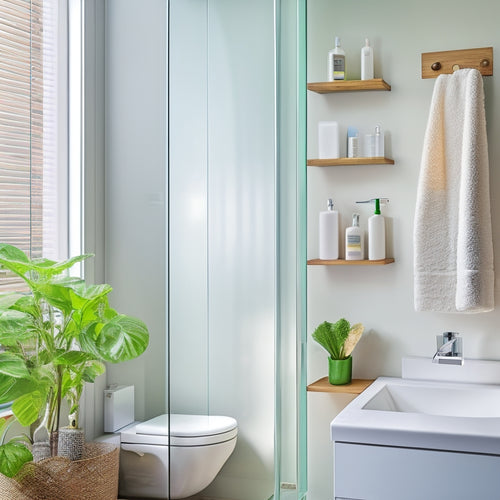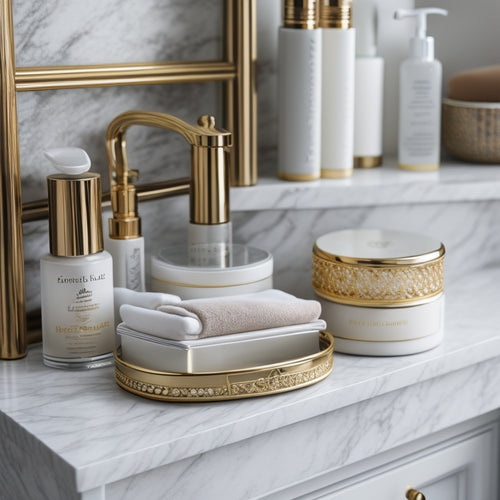
Installing a Toilet and Shower in a Small Bathroom
Share
When installing a toilet and shower in a small bathroom, start by accurately measuring the space, including length, width, and obstructions like windows and doors. Identify areas for optimization, especially the "wet zone," and note plumbing fixture locations. Choose a toilet that fits comfortably, prioritizing water efficiency and dual-flush capabilities. Select a shower fixture that complements the bathroom design, ensuring compatibility with home water pressure and local regulations. Prepare for installation by clearing the room, shutting off the water supply, and verifying it's completely shut off. Now that you've laid the groundwork, you're ready to take the next steps towards a successful installation.
Key Takeaways
- Accurately measure the bathroom space to optimize the toilet and shower layout, considering obstructions and plumbing fixture locations.
- Choose a toilet that fits comfortably in the bathroom, prioritizing water efficiency and considering factors like seat height and bowl shape.
- Select a shower fixture that complements the bathroom design, ensuring compatibility with home water pressure and meeting local water conservation regulations.
- Prepare for installation by clearing the room, shutting off the water supply, and verifying the water supply is completely shut off.
- Follow manufacturer's instructions for toilet and shower installation, paying attention to specific requirements like drain placement, waterproofing, and tile installation.
Measuring the Bathroom Space
Accurately measuring your small bathroom space is essential to secure a successful toilet and shower installation. You can't just eyeball it – you need precise measurements to guarantee a comfortable and functional space. Start by recording the length, width, and any obstructions, like windows or doors.
Don't forget to note the location of plumbing fixtures, such as the water supply lines and drainpipes. These plumbing considerations will affect your toilet and shower placement.
Next, identify the areas where you can optimize space. Consider the "wet zone" around the shower and toilet, where water is most likely to splash. This will help you determine the best layout for your fixtures.
Measure the distance between the shower wall and the toilet, as well as the distance from the toilet to the nearest wall or obstruction. With these exact measurements, you'll be able to plan your space optimization effectively, securing a smooth and successful installation.
Choosing the Right Toilet
With precise measurements of your small bathroom in hand, you're now ready to focus on selecting the right toilet for your space.
Don't worry, we won't make you sit through a lengthy lecture on toilet history (unless you're into that sort of thing). Instead, let's explore the nitty-gritty of toilet styles.
You've got three main options: round-front, elongated, and compact. Round-front toilets are perfect for tiny bathrooms, while elongated ones provide extra comfort. Compact toilets are a happy medium, but may not be as, ahem, comfortable.
Now, about water efficiency. Since you're working with a small bathroom, you'll want to prioritize toilets with low water consumption. Look for models with the WaterSense label, which indicates they meet EPA standards for water efficiency.
Some toilets even offer dual-flush capabilities, allowing you to choose between a partial or full flush. When selecting your toilet, consider factors like seat height, bowl shape, and flushing technology.
Don't be afraid to get a little picky – after all, you'll be, ahem, spending quality time with this toilet for years to come.
Selecting a Shower Fixture
As you move on from toilet selection, it's time to focus on the shower fixture, an essential component that can greatly impact the overall functionality and aesthetic of your small bathroom.
You'll want to take into account the type of shower you're installing, as this will influence your fixture choice. Are you going for a sleek rainfall showerhead or a more traditional wall-mounted option?
When selecting a shower fixture, keep the following factors in mind:
-
Shower types: Rainfall, wall-mounted, handheld, or body sprays - each has its own unique benefits and installation requirements.
-
Fixture materials: Choose from durable options like stainless steel, brass, or plastic, each with its own pros and cons.
-
Water pressure: verify your fixture can handle your home's water pressure to avoid a weak shower experience.
-
Flow rate: Select a fixture that meets local water conservation regulations and suits your personal preferences.
-
Style and finish: Pick a fixture that complements your bathroom's style and finish to create a cohesive look.
Preparing for Installation Day
You'll need to clear the room of any furniture, fixtures, and flooring that could get in the way of the installation or be damaged by water or debris.
Next, you'll shut off the water supply to the bathroom by locating the shut-off valves for the hot and cold water lines and turning them clockwise.
With the room empty and the water shut off, you'll be ready to begin the installation process.
Clear the Room
Clear the room of all personal items, towels, and accessories to guarantee a safe and obstacle-free workspace.
You don't want your favorite shampoo bottle getting crushed by a falling tile or your toothbrush getting tangled in a mess of pipes.
-
Remove all toiletries, towels, and rugs from the bathroom
-
Declutter items like toilet paper holders, soap dispensers, and trash cans
-
Take down any decorative items, such as images or mirrors, from the walls
-
Remove any floor mats or non-slip strips from the shower or bathtub
-
Cover the surrounding areas, like the floor and countertops, with drop cloths or plastic sheets to protect them from dust and debris
Shut Off Water
Turn off the water supply to the toilet and shower before starting the installation to prevent flooding and water damage. You don't want to be knee-deep in water while trying to figure out why your new toilet isn't working.
Locate the shut-off valves for the toilet and shower, typically found near the water supply lines. You may need to use plumbing tools like a wrench or pliers to turn the valves clockwise. Make certain they're fully closed to prevent any water from flowing.
Next, check the water meter or the main shut-off valve to verify the water supply is completely shut off. You can also open the faucet closest to the water supply line to drain the system.
This will prevent any water from flowing into the toilet or shower during installation.
Installing the Toilet First
Get ready to tackle the most vital aspect of your small bathroom renovation: installing the toilet. This is where precision and attention to detail are essential.
You'll need to make sure the toilet fits comfortably in the available space, so double-check the toilet dimensions to avoid any last-minute surprises.
Here's what you need to do:
- Measure the distance from the wall to the center of the toilet flange to determine the correct toilet model
- Inspect the flooring to verify it's level and can support the weight of the toilet
- Identify the plumbing connections and shut-offs for the water supply and drainage
- Choose the right wax ring or toilet gasket for a secure seal
- Follow the manufacturer's instructions for specific installation requirements
Shower Installation Challenges
The shower area in your small bathroom renovation is a complex puzzle, where every piece must fit snugly to guarantee a watertight seal and effective water flow. One wrong move, and you'll be dealing with water damage, mold, and a bunch of other headaches. So, let's break down the challenges you'll face during shower installation.
| Challenge | Description | Solution |
|---|---|---|
| Drain Placement | Figuring out where to place the drain to ascertain proper water flow and avoid water accumulation | Measure the shower area carefully and choose a drain location that's centered and slightly sloped |
| Waterproofing | Applying effective waterproofing techniques to prevent water seepage and damage | Use a combination of waterproof membranes, sealants, and drainage systems to create a watertight seal |
| Tile Installation | Laying tiles that fit snugly around the shower's curved edges and corners | Use tile spacers and a level to ascertain straight lines and even gaps |
| Shower Head Placement | Positioning the shower head at the right height and angle for ideal water flow | Measure the shower area and consider the user's height to determine the perfect shower head placement |
Frequently Asked Questions
Can I Install a Toilet and Shower in a Bathroom With a Slanted Floor?
You're wondering if you can defy gravity with a slanted floor, and the answer is yes, but you'll need clever drainage solutions to prevent water from pooling and creating a slip 'n slide effect in your bathroom oasis.
How Do I Ensure Proper Drainage in a Small, Poorly Ventilated Bathroom?
You're maneuvering a tight spot, like trying to squeeze into a crowded elevator, but don't sweat it! To guarantee proper drainage, you'll need to implement clever drainage solutions, such as sloped floors and strategically placed drains, paired with ventilation tips like powerful exhaust fans to banish moisture.
Are There Any Specific Toilet and Shower Combinations for Small Bathrooms?
When shopping for toilets and showers, you'll find compact fixtures designed specifically for small bathrooms. Look for space-saving designs like wall-mounted toilets and corner showers that'll optimize your floor space without sacrificing functionality or style.
Can I Install a Toilet and Shower Myself, or Do I Need a Professional?
You're wondering if you can tackle DIY plumbing? While it's possible, consider your tool requirements and skill level. If you're not comfortable with pipe wrenches and water shut-offs, it's best to leave it to a pro to avoid a flooded mess!
What Are the Most Common Mistakes to Avoid During Toilet and Shower Installation?
When tackling toilet and shower installation, you'll want to sidestep common plumbing pitfalls by following expert installation tips, such as precisely measuring drain lines, securely fastening fixtures, and ensuring proper water pressure to avoid messy, costly mistakes.
Conclusion
You've conquered the cramped quarters, chosen the perfect fixtures, and managed the installation process. Now, your small bathroom boasts a sleek, functional toilet and shower. As you step back to admire your handiwork, remember that precision and planning paved the way for success. Just as each tile fell into place, so too did each careful measurement, deliberate selection, and thorough installation step. Your newly refreshed space is a proof of the power of deliberate design and execution.
Related Posts
-

Space-Efficient Shower Organizers for Modern Apartments
If you're looking to maximize space in your modern apartment's shower, consider clever organizers that blend style wi...
-

Discover Essential Korean Vocabulary for Beginners
You'll need to master a range of essential Korean vocabulary to effectively communicate and navigate everyday situati...
-

Revamp Your Bathroom Drawers With Expert Tips
I'm ready to transform my bathroom drawers from cluttered chaos to serene sanctuaries. First, I'll empty and sort ite...


